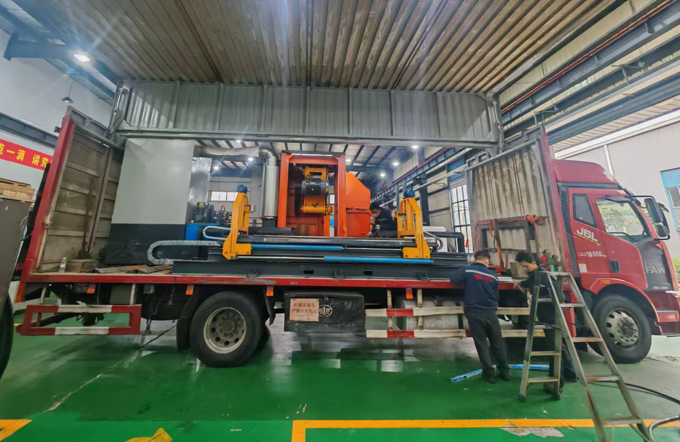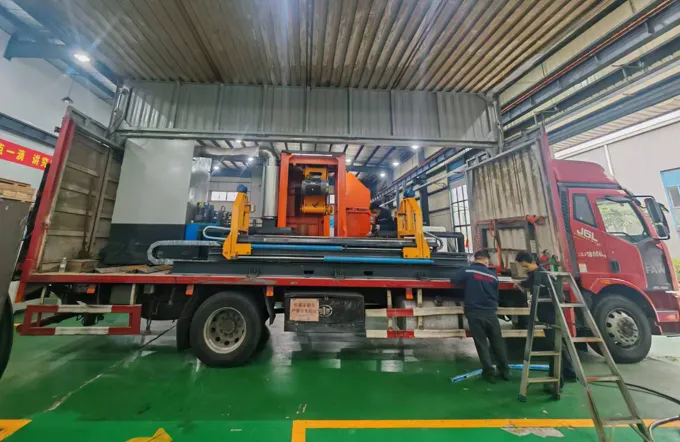Oct 28, 2025

The paper roll saw is an essential industrial tool designed to modify the width of paper rolls. Its primary functions include trimming damaged edges from rolls that have been compromised during handling or storage, and cutting larger rolls into narrower, more manageable widths for specific production requirements. Given its critical role in paper processing and logistics, understanding how to safely and effectively transport this equipment on a truck is vital for operational efficiency and safety.
A paper roll saw serves two main purposes in paper manufacturing and conversion facilities. First, it is used to remove damaged or defective sections from the edges of paper rolls—a common issue arising from transportation, storage, or mechanical handling. By trimming these sections, the saw helps minimize waste and preserve the usability of the roll. Second, the equipment enables operators to cut wide master rolls into custom widths tailored to specific orders or machinery, such as printing presses or packaging lines. This flexibility is especially valuable in industries where precision and adaptability are crucial, such as in the production of labels, flexible packaging, and specialty papers.
Due to its specialized function, the paper roll saw is typically stationed near roll storage areas to facilitate quick processing. However, mounting it on a truck allows for mobility, enabling the equipment to be deployed across multiple sites—such as different warehouses, satellite production facilities, or even client locations—for on-demand cutting operations.
When transporting a paper roll saw via truck, selecting an appropriate vehicle is the first critical step. The truck’s dimensions and weight capacity must align with the saw’s size and mass. An overloaded or improperly sized truck can lead to regulatory violations, safety hazards, and potential damage to both the equipment and the vehicle. Key parameters to verify include the truck’s gross vehicle weight rating (GVWR), deck space, and axle load limits.
Moreover, the paper roll saw’s weight distribution is often uneven due to its motor, cutting assembly, and structural frame. This uneven mass can create instability during transit if not properly secured. Ideally, the saw should be positioned low within the truck bed, close to the vehicle’s center of gravity. Hydraulic load-bearing systems are highly recommended for this purpose. These systems can dynamically adjust support, evenly distributing weight and reducing stress on the truck’s chassis and suspension. Additionally, using reinforced loading ramps and steel anchoring points will prevent shifting during movement.
Beyond transport considerations, the truck’s layout must accommodate operational needs. Ample space should be reserved for the operator to safely run the saw and perform ancillary tasks such as cleaning debris, replacing blades, or conducting minor maintenance. A cramped workspace increases the risk of accidents, particularly when handling sharp cutting components or moving heavy paper rolls.
The design should include dedicated areas for tools, spare parts, and personal protective equipment (PPE). Non-slip flooring, adequate lighting, and ventilation are also essential, as paper dust and particles can accumulate quickly during cutting. If the saw is powered by an independent generator or the truck’s electrical system, cables and power units must be organized to avoid tripping hazards. For longer assignments, providing basic amenities—such as a seating area or storage for hydration—can help maintain operator focus and productivity.
To maximize the benefits of a truck-mounted paper roll saw, operators should adopt several best practices. Regular inspections of both the saw and the truck are necessary to identify wear or potential failures. This includes checking blade sharpness, hydraulic hose integrity, and tire pressure. Furthermore, securing necessary permits for oversized loads and planning routes in advance can prevent logistical delays.
Training is another crucial element: operators should be familiar with emergency protocols, such as how to quickly disengage the saw or stabilize the truck in case of instability. Implementing a pre-operation checklist—covering aspects like weight distribution, blade alignment, and clearance around the work area—can standardize safety procedures across different job sites.
In summary, using a truck to transport and operate a paper roll saw offers valuable flexibility for paper-based industries. However, this approach requires careful attention to vehicle selection, load management, and workspace design. By prioritizing structural compatibility, balanced weight distribution, and operator safety, companies can enhance both mobility and productivity while minimizing risks.
Main Products
Social Media
Social Media
Contact Us
+86 0512 5510 8067
Room 3, No.2159, Beimen Road, Yushan Town, Kunshan City, Jiangsu Province, China
Inquiry
Inquiry
News Center

November 01, 2025
A Comprehensive Guide to Paper Bags: Materials and Applications

October 28, 2025